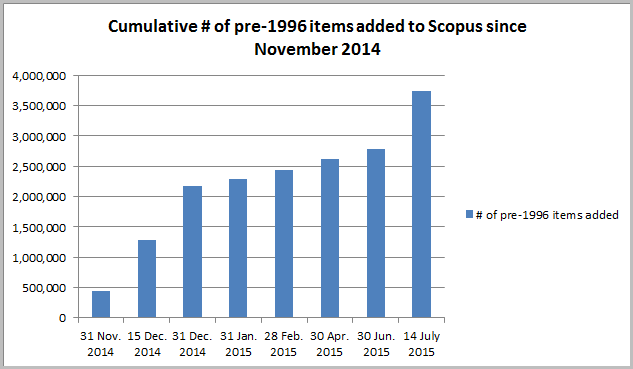Breaking the 1996 barrier: Scopus adds nearly 4 million pre-1996 articles and more than 83 million references
Scopus data has been growing exponentially over the last year — and perhaps not in the way you might expect. In the last 7 months, Scopus has added over 83 million pre-1996 cited references to nearly 4 million articles.
| Currently, the average number of references per pre-1996 article is 22.9. |
This has been achieved in two ways; by adding pre-1996 cited references to existing articles, and by adding article back files, including their cited references, from the archives of 36 major publishers, going back to 1970. Keep in mind that this is only the beginning. By the end of 2016 we anticipate that these numbers will grow to approximately 12 million* complete records for pre-1996 articles, contributing more than 150 million cited references. This is on top of the 1 billion plus references already included in Scopus today.
* Note: We expect to reach 10 million records by the end of this year.
What does this mean for you, the researcher?
Scopus is not limited to post-1995 cited reference data and can provide you with long-term, extensive bibliometric and historic trend analyses. Additionally, more complete records equals more complete author profiles and h-index measurements for individuals who began publishing prior to 1996 — providing all researchers with better insight into key field influences and leaders.
To put this in perspective we can look at a senior researcher like David Neal, who began publishing in 1981. In Scopus, the expanded content means a portion of his 113 pre-1996 documents have now been re-indexed, adding approximately 3,146 citations so far to his overall citation count and increasing his h-index to 67. Two of those documents (one from 1993 and the other from 1985) account for his 3rd and 4th most cited work.
| On average, senior researchers have seen their h-index score increase by 24% since the initiation of the cited reference expansion project. |
As the expansion continues and more of his pre-1996 documents are re-indexed, these numbers are expected to further increase.
Examples like this not only bring welcome news for senior researchers like David Neal, there are profound benefits for all researchers. Overall, the cited references expansion program improves the completeness of the database that, when combined with the analytical capabilities of Scopus, provides you with deeper understanding of research — so you can understand what has been done, what is being done, and what needs to be done. Or, in the words of the late physiologist Albert Szent-Gyorgyi to fulfill the purpose of research: ‘to see what everybody else has seen, and to think what nobody else has thought.’ Bioenergetics (1957).
Just more content, or more quality content: What is being added?
With this project, Scopus also retains its focus on content quality, not just content quantity. The additional content covers article archives from journals already included in Scopus, meaning these titles have already been evaluated and approved by the independent Content Selection and Advisory Board (CSAB). At the publisher level, Scopus plans to add 36 publisher archives to the database.
| Titles suggested to Scopus must meet 5 minimum criteria to be considered eligible for review by the CSAB. On average Scopus receives 3,000 title suggestions annually. In 2014, 767 of the total titles suggested met the minimum criteria and were sent through to the CSAB for review, resulting in 324 (42%) titles being accepted into Scopus. |
Archives already completed include: Springer, American Physical Society (APS) and Elsevier. For these three archives the complete article collections are already indexed in Scopus, so only the cited references needed to be added. This work has been completed in close partnership with Data Conversion Laboratory (DCL), an industry leader in organizing and converting content into digital formats.
The Springer archive alone adds approximately 21.7 million cited references to over 1.2 million articles in the Scopus database. This is the most recent archive added.
Additional archives currently in process include: Walter de Gruyter, Lippincott Williams & Wilkins, American Society of Civil Engineers, and the Institute of Electrical and Electronics Engineers (IEEE). For these archives both pre-1996 articles and cited references are being added.
Also in the pipeline are, Taylor & Francis, Institute of Physics (IoP), Karger Publishers, Society of Photographic Instrumentation Engineers (SPIE), Brill Publishers, Royal Society of Chemistry, Oxford University Press, Sage, and Emerald Group Publishing, among others.


